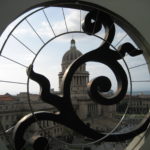Train-Hopping in Europe

If you haven’t been to Europe yet or are dying to go back, consider traveling by rail. Train travel is a fun and affordable way to get around, and usually the best way to see and explore the most important destinations in each country. Most major cities and even smaller towns are connected by train and stations are often in the heart of each city, making it easy to start exploring immediately upon arriving.
Every country within Europe has their own rail system and different names for the types of trains on their lines. You will find anything from local and regional trains that make very frequent stops in both the larger cities and smaller towns, as well as high-speed trains that travel between major cities and even service neighboring countries. Between London and Paris, for example, you have the Eurostar, getting you between the cities in just under 2.5 hours (going up to 186 mph).
When you’re ready to
go, keep in mind these helpful tips:
- Buy a pass or single tickets: You can purchase country or multi-country passes that can save you money if you’ll be taking many trains. If doing so, check restrictions, as often there are supplements to pay for seat assignments and fast trains. Otherwise you can purchase single tickets, which can also be purchased online. Buy your tickets in advance to save money!
- Pack light: You will be carrying your own bags, across the stations, onto the train, and even placing them overhead when space is limited onboard. Some train stations require going up and down stairs with no elevators or escalators between platforms. Make sure you leave behind things that would be “nice to have” and bring only what you “need to have”. You’ll thank yourself for it!
- Buy snacks: Even though some trains have café/bar cars, it is common to see travelers with their own picnic meals. Hit a supermarket (larger train stations have them onsite) or one of the sandwich shops at the station and even bring some wine or a beer to enjoy during your ride. Don’t forget the corkscrew!
- Choose nearby hotels: To avoid dragging your luggage too far and to save money on transportation, consider choosing hotels near the train stations. In larger cities, most central train stations are located in the city center and near most attractions. If you arrive too early to your hotel, they will often allow you to check your bags with the porters, or you can leave your bags at the luggage check that many larger train stations offer (for a fee of course). Make sure to check the area for safety before booking!
 And here are some of my favorite rail itineraries in Europe, to get you started:
And here are some of my favorite rail itineraries in Europe, to get you started:
- London & Paris: 3 nights in London, Eurostar train London to Paris, 3 nights Paris. Take the local trains in London to Windsor and in Paris to Versailles.
- Northern Italy and Southern France: 2 nights Lake Maggiore, train to Santa Margherita Ligure (Italian Riviera), 2 nights in Santa Margherita, train ride through the Cinque Terre, train to Nice, 3 nights in Nice, day trip by train to Monaco and Cannes, TGV fast train to Paris, 3 nights in Paris.
- Italy: 3 nights in Rome, fast train Rome to Florence, 2 nights in Florence, fast train Florence to Venice, 2 nights in Venice. Take side trip by regional train to Siena, Pisa or Lucca from Florence.
- Spain: 3 nights in Madrid, day trip by train to Toledo, train to Seville, 2 nights Seville, train to Cordoba, 2 nights Cordoba, train back to Madrid, 1 night in Madrid.
Europe’s history, architecture, old-world charm, and delicious food are just some of the reasons why you have to get out there and experience it for yourself. While planning your trip, check out the websites for each country’s national rail system and map out your itinerary. Traveling by train is really the best way to go, whether traveling solo or with your family! All aboard everyone, Europe awaits!
By Annette Morejon, owner Daiquiri Tours, Miami Springs
Oct 22, 2018




